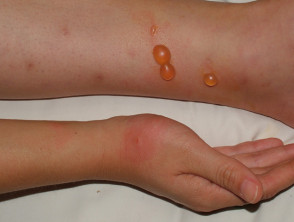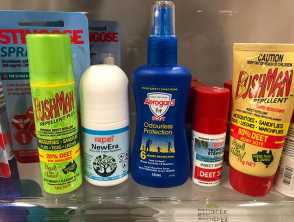What is an insect repellent?
Insect repellents are agents used to deter insect bites and stings to reduce the risk of local and systemic effects, including insect-borne diseases.
What are insect repellents used for?
Insect repellent (also known as ‘bug spray’) aims to reduce the risk of local cutaneous reactions from insect bites (eg, mosquito bites) and prevent serious insect-borne diseases including malaria, zika virus, West Nile virus, dengue fever, yellow fever, and chikungunya fever. Lyme disease is spread via bites from infected ticks.
How do insect repellents work?
Most insect repellents work on the principle of creating a vapour barrier that deters the insect from coming into contact with the skin.
- For example, to find a host to feed on, mosquitoes use odorant-binding proteins (OBPs) to detect odours that are released by human skin. Insect repellents such as DEET inhibit mosquito OBPs to deter them from biting human hosts.
- It is difficult to find a single active chemical that is effective against the many different species of disease-carrying insects.
Some insect repellents can be applied to fabrics or to surrounding environmental structures; others should be applied directly onto the skin.
An ideal insect repellent should be (although to date no repellents meet all of these criteria):
- Active against a variety of biting insects
- Cosmetically appealing (eg, acceptable odour or odourless and not too greasy)
- Resistant to sweating / hand washing / abrasion
- Able to provide long-lasting protection
- Non-irritating, non-sensitising and non-toxic
- Chemically stable and non-reactive with commonly used plastics
- Economically viable for widespread use.
Insect repellents should be used in combination with physical controls such as suitable clothing, mosquito nets, and removal of environmental debris which could be used as breeding areas.
There are 2 types of insect repellents: chemical, or plant-derived.
Chemical insect repellents
DEET
- Chemical name: N, N-diethyl-3-methylbenzamide.
- The most broad-spectrum and effective insect repellent developed to date.
- Available in concentrations ranging from 5–100%.
- 10–35% concentrations provide effective protection; there is thought to be no real additional benefit to using concentrations above this.
- 50–75% concentrations may cause urticaria, vesiculobullous skin necrosis, and cardiovascular and neurologic complications.
- Available in a range of formulations including solutions, lotions, creams, gels, aerosol and pump sprays, and impregnated towelettes.
- Use with caution in combination with sunscreen, as:
- DEET reduces sunscreen efficacy by up to one-third, so more frequent sunscreen re-application may be necessary
- Sunscreen may also increase systemic absorption of DEET and potential toxicity.
- When used properly, DEET has an excellent safety record and is considered safe in pregnancy and breastfeeding (although avoid application to the breast area).
- Licensed for use in children from 2 months of age at reduced concentrations.
Picardin
- Also known as icaridin and propidine.
- Available in concentrations of 7–20%.
- Odourless, does not feel sticky or greasy when applied.
- Low potential for toxicity and unlikely to cause skin irritation.
- Similar efficacy to DEET; however, in high-risk situations DEET is recommended as it is available in higher concentrations.
- Can be used in pregnancy and breastfeeding.
- Not recommended in children younger than 2 years.
IR3535
- Colourless, almost odourless, biodegradable.
- Available in concentrations 7.5–20%.
- Appears to have similar efficacy to DEET at concentrations <20%.
- Not recommended for babies under 6 months.
Plant-derived insect repellents
Although some plant-based repellents have shown effective repellent activity, to date none demonstrate the broad effectiveness and duration of protection of DEET and are therefore not recommended in moderate or high-risk situations.
Permethrin
- An insect repellent and insecticide derived from extracts of the chrysanthemum flower.
- Should not be directly applied to the skin as it is intended to treat fabrics.
- Permethrin spray is almost odourless and retains its potency for at least 2 weeks. It should be reapplied after every 5 washings.
- Permethrin is toxic at high doses. Effects include eye and skin irritation, tremors, loss of coordination, hyperactivity, and paralysis.
Others
- Oil of Lemon Eucalyptus (derived from Corymbia citriodora).
- Citronella (derived from Cymbopogon nardus).
- Catnip oil (derived from Nepeta cataria).
- 2-Undecanone (derived from Lycopersicon hirsutum Dunal f.glabratum).
What are the benefits of insect repellent?
- Reduced risk of local and systemic effects of insect bites, and insect-borne diseases.
What are the disadvantages of insect repellent?
- Insect repellent must be reapplied if sweating or swimming.
- Many preparations are cosmetically unappealing due to an unpleasant odour or feel greasy when applied.
- DEET and IR3535 may degrade synthetic materials including vinyls and plastics.
What are the side effects and risks of insect repellent?
- Used correctly, they are safe and toxicity is rare.
- The most common side effect of insect repellent is local irritation or eye irritation.
What are the precautions and contraindications with insect repellent?
Contraindications
- Hypersensitivity to a particular insect repellent.
Precautions
- Do not apply to broken skin, into the eyes or other mucous membranes, or inhale the vapour.
- Do not apply to large areas of skin; use in combination with clothing to limit the skin area available to the biting insect.
- Caution with concurrent use with sunscreens, which can reduce sunscreen efficacy and increase the risk of sunburn and other photo-damage.

